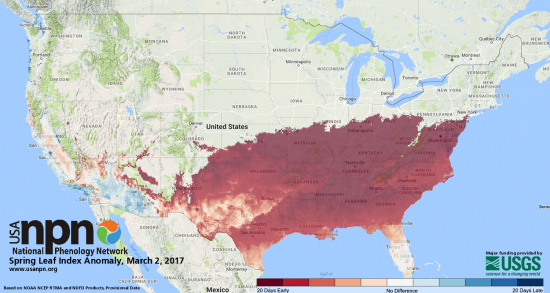March 2, 2017 – According to scientists studying the evidence of changing climate in Greenland, spring is arriving 26 days earlier than it did a decade ago. And in the United States, in Washington, DC, spring is 22 days earlier.

How do climate scientists justify this claim?
It is based on observing the calendar record of emerging plants and migrating animals and their first appearance and is part of the science of phenology. Cyclic, seasonal phenomena in nature can be observed by citizen scientists. We can gauge the early budding of trees. I for one have noted that here in Toronto budding and leafing is happening weeks earlier than when I was younger. I cannot tell you by how many dies but it is noticeable. The earlier arrival of robins, however, is something I have been noting for many years. The robin is, to me, the bird that is the harbinger of the return of spring in this area of the world. I remember when robins arrived in the first or second week of March. That was not much more than a decade ago. But this year I saw my first on February 23rd and heard robin birdsong several days previously before finally spotting one. We who have gardens can mark the changes to the timing of bulbs when they first send shoots above the soil surface or the change in the colour of dormant grasses as they begin to green up. These are biological phenomena that are seasonal occurrences.
What triggers them? Three factors:
- Changes in daylight duration and the angle of the sun
- Changes in precipitation (from snow to rain)
- Changes in air, soil and water temperature
Birds use duration of sunlight and the angle of the sun in the sky to trigger northward migration. They also use temperature. If it is warmer earlier they may migrate earlier. We know that sunlight and the angle of light don’t alter from year to year, but temperatures can. Plants also use sunlight in the same way birds do. They too react to warming surface temperatures, snow cover and precipitation changes. Other biological species respond to seasonal changes including hibernating mammals, reptiles, amphibians, and insects. What is interesting is that every living species on our planet marches to a different drummer when it comes to seasonal change. So the pattern isn’t uniform. Although robins may arrive earlier than in past decades, other birds may not. And one tree species may sport early budding while others remain dormant for much longer.
Plants, like birds, use sunlight. They also react to soil warming, air temperature changes, snow cover, and precipitation.
Other species of animals and plants respond as well. Every living species on the planet marches to a different phenological drummer. So patterns aren’t uniform.
Although robins may arrive earlier than in past decades, other birds may not.
And one tree species may sport early budding while others remain dormant longer.
But what is being observed in the Arctic, in particular in Greenland, is a pattern not seen before. Eric Post, a polar ecologist at UC Davis, describes his astonishment about the changes observed over the 27 years he has been studying this area of the world. In an article appearing on March 1, 2017, in The Guardian, he states, “When we started studying this, I never would have imagined we’d be talking about a 26-day per decade rate of advance….That’s almost an entire growing season. That’s an eye-opening rate of change.”
The latest maps dated March 2, 2017, produced by the United States Geological Survey (USGS), and the National Phenology Network, indicate a spring leaf index change in much of southeastern portions of the country by as much as 20 days. Spring leaf index tracks the timing when the first leaves emerge after budding.

Also quoted in The Guardian article, is Dr. Jake Weltzin, from the USGS, who is also National Director of the National Phenology Network. He comments, “While these earlier springs might not seem like a big deal – and who among us doesn’t appreciate a balmy day or a break in dreary winter weather – they pose significant challenges for planning and managing important issues that affect our economy and our society.”















